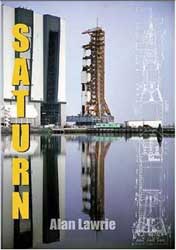
The Saturn V richly deserves the many superlatives heaped upon it. The most apt is it being described as nearly 6 million pounds of explosive fuel waiting for a match to set it alight. Striking as this sounds, it was the control of the resulting exothermic reactions that gently pushed man and machine into the space age. However, where the car industry could continually make corrections to correct design flaws, these rockets had to perform nearly flawlessly every time. This ensured the safety of the people and the achievement of the assigned mission. As well, these rockets were at the centre of a race between nations, thus there was an impassioned need to build, test and use them as quickly as possible. Thus, judicious testing ensured that each Saturn V rocket was ready to perform when called upon.
The author’s goal is to recover and present the manufacturing steps and test results of the Saturn V stages. They admirably do so. In a manner that would warm many engineers’ hearts, though perhaps bore the average reader, the authors list relevant dates, locations and events for each stage produced. That is, there’s a review of the 19 S-IC stages, the 27 S-II stages, and, the 26 S-IVB stages. The stages are listed in a numeric, hence chronological, sequence and all reviews follow the same format. There’s a short, one paragraph summary of the stage’s eventual use, a description of its manufacturing history and a listing of the testing of the complete stage, usually focusing on the all up test that included static firing of the engines. The test results get listed immediately after, as are any abnormalities. With this expansive coverage of the testing, the book well meets its goal of providing a record of Saturn V’s manufacturing and tests.
Supporting this compilation is a quick survey of some support elements. There’s a review of the J-2 and F-1 engines, the Pregnant Guppy and Super Guppy cargo aircraft, the barges and the relevant development centres. Of interest, the J-2 may be produced again for the Crew Launch Vehicle’s upper stage. These short asides are brief but useful additions to help the reader understand the enormity of the project.
Though the book provides extensive information, it’s not exhaustive. As the authors note, there’s a massive quantity of records in storage, with little to no organization to aid in searching through it. As such, problems encountered while testing are simply stated, such as ‘a minor bearing overheating problem was encountered during the move’. There are even slight traces of levity, such as the comment �the failure was due to the inability to abort 3.2 million pounds of water�. But humour isn’t the goal; this book is a collection of information and facts solely.
Accompanying this book’s sound review is an excellent potpourri of photographs, videos and historical documents. The book has a centre section with many colour plates of test firings, stage construction or simple transportation. Black and white pictographs are sprinkled throughout the text. The videos and support documentation are in the enclosed DVD. One can easily enjoy the sonic reverberations kicking through the speakers when viewing really close up images of the engine tests!
Though the book is large, the manufacturing and test record pages are a bit less than half. The remainder are reprints of two historical NASA publications, the Saturn V News Reference and the Saturn V Payload Planner’s Guide. Both these documentations provide background information. The first provides a ready review of the details of the Saturn V’s design, while the later is a marketing brochure that advertises the rockets capabilities, in the unfulfilled hope that many more would be built. By adding these, the book becomes an excellent reference for Saturn V enthusiasts as well as those interested in engineering test programs or large equipment handling and manufacturing.
Though the Saturn was a rocket, it was also a system. Millions of individual pieces, each serving their own function, had to operate in unison. Alan Lawrie and Robert Godwin in their book Saturn V recover all the manufacturing steps and test results that together gave the confidence to the engineers to say that this system was worthy to send a human on a journey into space.
Review by Mark Mortimer
Copies are available for purchase from Countdown Creations.
